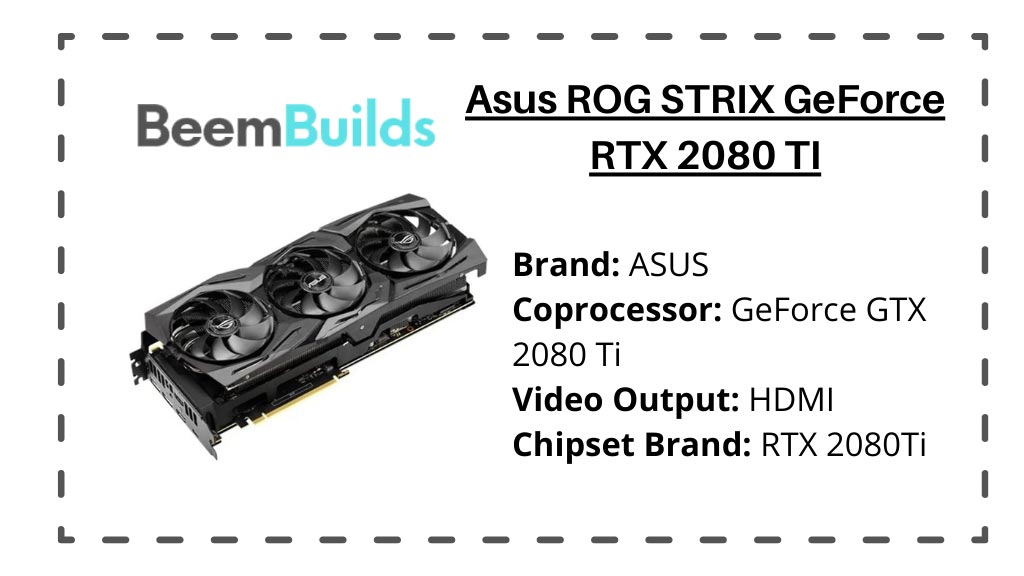New technologies are incorporated into products by companies all the time. Games are not immune to these changes either. The RTX series of Nvidia graphics cards offer Real-Time Ray Tracing and DLSS, providing a better gaming experience compared to the previous generations. Meanwhile, virtual reality is also revolutionizing gaming.
Even though there are not many VR games available, the number of VR games is growing. Those who haven’t used VR before are in for a treat. It puts you in a 3D world and provides a realistic, immersive experience that they hadn’t experienced in all the years they’ve been gaming. In order for VR to run smoothly, it needs high-end hardware. Find out which are the best graphics cards for VR.
9.7
- Brand: MSI
- Chipset Brand: NVIDIA
- Coprocessor: GeForce RTX 2060
9.3
- Brand: Gigabyte
- Chipset Brand: RTX 2070 Super
- Coprocessor: NVIDIA GeForce RTX 2070
9.2
- Brand: ASUS
- Chipset Brand: RTX 2080 TI
- Coprocessor: NVIDIA GeForce RTX 2080 Ti
We’ll start our list shortly, but before buying a graphics card you should know a few things. You need a high-end graphics card to run VR because it requires two displays, one for each eye, and very low input lag. Virtual Reality Gaming requires a video card as powerful as a GTX 970 or AMD R9 390 as well as a processor as powerful as an Intel Core i5 4th generation. You can get immersive performance from all the graphics cards below, and they are all VR-ready.
You may also love to read: Best Low Power Graphics Cards Without External Power
In addition to being VR ready by the manufacturers, these graphics cards offer great value given the price they are offered for. According to the research we did, they are better than their competitors and other GPUs. We’ll start with the guide of Best Graphics Cards for VR without wasting any time.
Table of Contents
Our Recommendations for Best Graphics Card for VR
- MSI Gaming Radeon RX 5700
- MSI Gaming GeForce RTX 2060
- XFX Radeon Rx 590 Fatboy
- ZOTAC Gaming GeForce GTX 1660 Ti
- Gigabyte GeForce RTX 2070
- Asus ROG STRIX GeForce RTX 2080 TI
1. MSI Gaming Radeon RX 5700 – Best Overall Graphics Card for VR
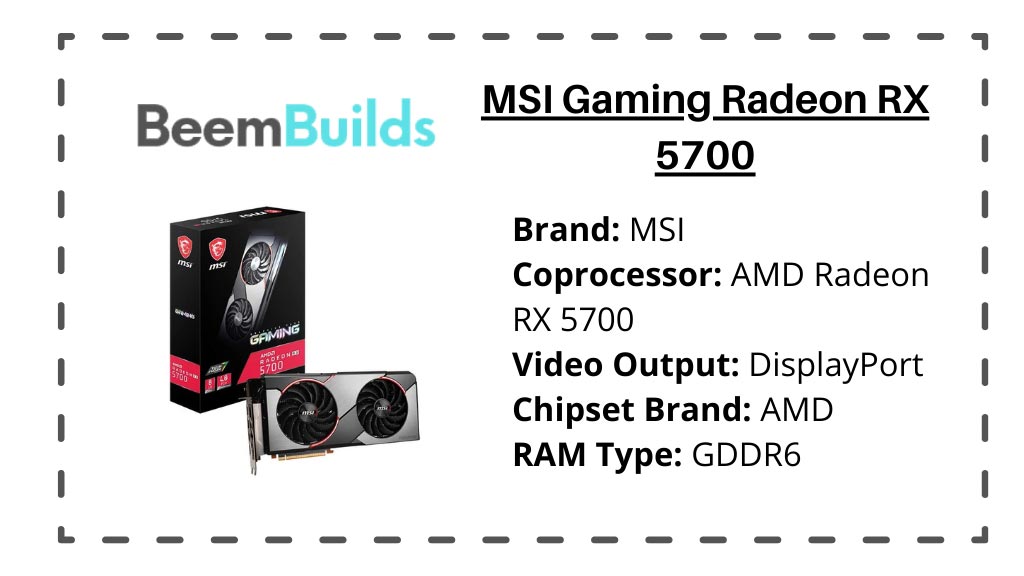 All MSI graphics cards are made with the same high-quality components as those from other top-tier companies. Its performance is at least equal to the RTX 2070 Super, making the MSI Gaming Radeon RX 5700 the Best Graphics Card for VR gaming. Considering the best cooling system in the class as well as the higher clock speeds than ASUS and Gigabyte models, we recommend this vendor. There are no changes to the design. These cards are now available in a metallic silver color scheme, as opposed to the black and red of Gaming X cards.
All MSI graphics cards are made with the same high-quality components as those from other top-tier companies. Its performance is at least equal to the RTX 2070 Super, making the MSI Gaming Radeon RX 5700 the Best Graphics Card for VR gaming. Considering the best cooling system in the class as well as the higher clock speeds than ASUS and Gigabyte models, we recommend this vendor. There are no changes to the design. These cards are now available in a metallic silver color scheme, as opposed to the black and red of Gaming X cards.
RTX 2070 Super and this graphics card are both 2300+ core units, so their general specifications are similar. With overclocking, it is overclockable up to 1750 MHz. As of now, this graphics card is running at around 1500 MHz. In terms of memory, 8GB should be enough for most AAA titles, but you should stick to 1440p because 4K might negatively impact the performance. As this graphics card is priced similarly to the RTX 2070S, its price difference is comparable.
The MSI Gaming Radeon RX 5700 is one of the best graphics cards for VR. Despite all of its goodness, however, you might find some cons when you use it.
You may also love to read: Best GPU For AMD FX 8350
DLSS and Real-Time Raytracing are not available on this graphics card since they are exclusive to RTX series GPUs. I would prefer the RX 5700xt graphics card over this one since it is not much more expensive while performing much better. The power consumption is high, so you should get at least a 500-600 Watt power supply for it.
As a result of the low hardware, this graphics card will deliver excellent VR performance. In terms of performance in 1440p resolution, we consider this GPU the best overall. With Assassin’s Creed Unity at ultra settings and FX AA, we were able to get 90 frame rates while with the RX 5700xt, we got 110 frames. This Best Graphics Card for VR has a performance that makes it suitable for midrange gaming.
- Graphics card that is VR Ready.
- VR and gaming GPUs.
- An excellent 1440p display at an affordable price.
- For a low price, the RTX 2070S includes all of the basic features.
- GPU that consumes a lot of power.
- No real-time ray tracing or DLSS.
- Despite being slightly more expensive, the RX 5700xt is much better.
2. MSI Gaming GeForce RTX 2060 – Best Runner-up Graphics Card for VR
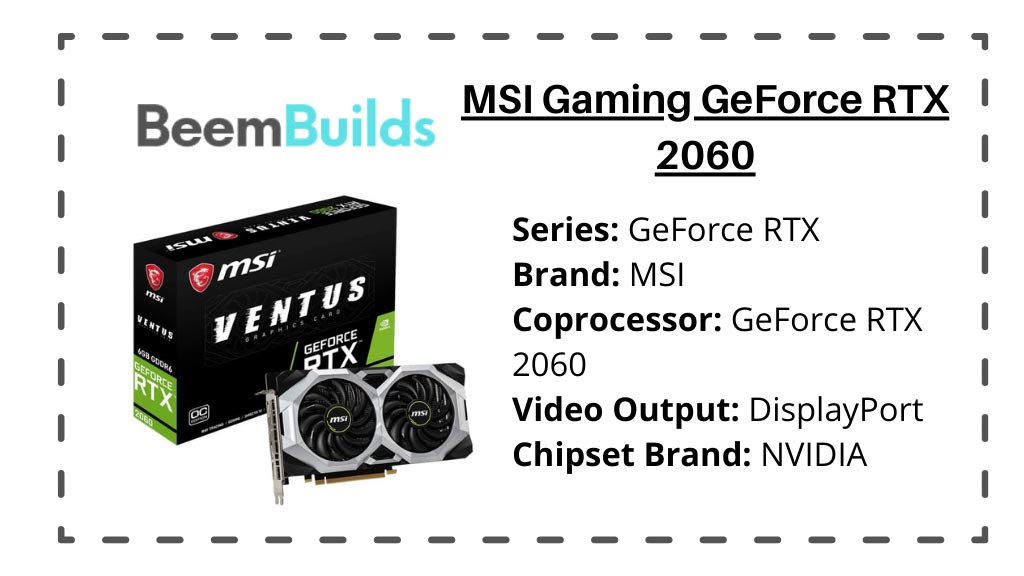 In our second review, we found another MSI graphics card, this time a RTX 2060 from the same lineup as the GTX 1060, this time from their Gaming series. Due to its price and performance, this graphics card provided a significant boost to entry-level RTX cards. This graphics card is faster than some previous generation cards like the GTX 1070ti, but it boasts DLSS and RTX, both available in the 20-series GPUs. RTX 2060 supports Real-Time Ray Tracing, but it can adversely affect frame rates.
In our second review, we found another MSI graphics card, this time a RTX 2060 from the same lineup as the GTX 1060, this time from their Gaming series. Due to its price and performance, this graphics card provided a significant boost to entry-level RTX cards. This graphics card is faster than some previous generation cards like the GTX 1070ti, but it boasts DLSS and RTX, both available in the 20-series GPUs. RTX 2060 supports Real-Time Ray Tracing, but it can adversely affect frame rates.
In addition, entry-level graphics cards come with 6GB of GDDR6 memory, which is something, but most GPUs today come with 8GB. You can overrate the processor to get higher performance by increasing the clock speed to 1750Mhz. There are 1920 Cuda cores, as well as 17 trillion RTX operations per second. This GPU is energy efficient and does not require a lot of power consumption with a 500-550W power supply. If you want a powerful RTX series card, but don’t want to spend a lot, this card may be the best option.
You may also love to read: Best Graphics Card for After Effects
Although this entry-level RTX series hardware provided impressive performance, there are some negatives you should know. In terms of price, the RX 5700 is almost the same as this GPU; take a closer look at it. It might already be known that modern GPUs offer VirtualLink Ports as an excellent alternative to USB Type-C, whereas this one does not. The backplate on this graphics card is made of plastic, which looks odd because graphics cards usually have metal or steel black plates. Before purchasing this Best Graphics Card for VR, consider these things. Then you can make an informed purchase.
Although the RTX 2060’s performance is similar to that of the RX 5700, AMD GPUs do have an advantage in some games such as Battlefield 1 and ROTTR. Assassin’s Creed Unity runs at 85 frames per second with this GPU, at 1080p resolution, ultra settings, and FXAA enabled. This VR graphics card is capable of sufficient performance even if you switch off Ray Tracing. Generally, it would perform well in VR games, but its high refresh rate might be missed.
- GDDR6 memory of 6GB.
- Excellent performance in 1440p.
- Graphics card that uses little energy.
- Performance of the Founders Edition is better.
- Port Type-C (VirtualLink) cannot be used.
- Backplates are made of plastic.
3. XFX Radeon Rx 590 Fatboy – Best Entry-Level AMD Graphics Card for VR
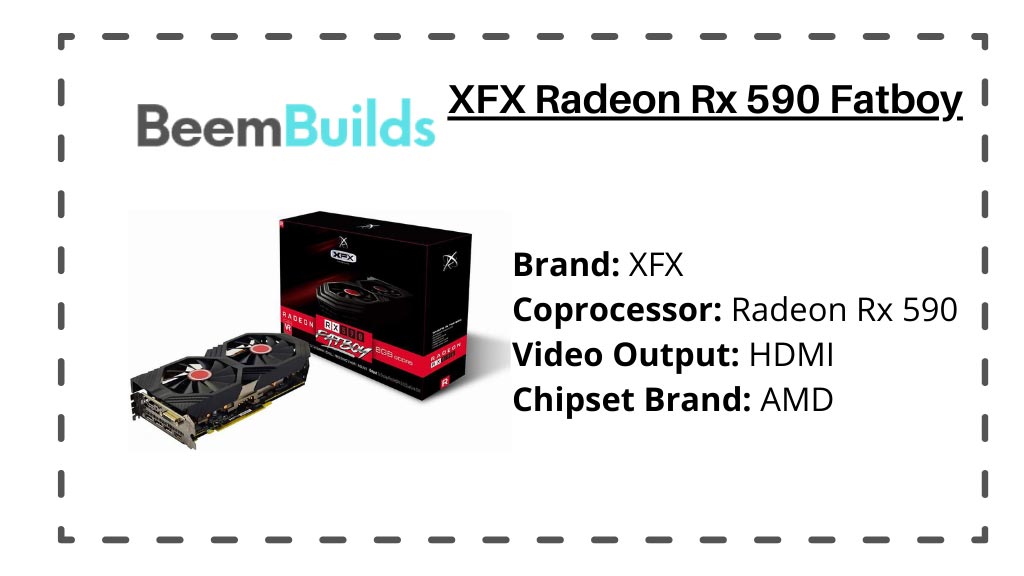 It is unlikely that there are any other competitors in AMD graphics cards because XFX offers the best cooling system and cost is low enough. There are minor changes in specifications in the XFX Radeon Rx 590 Fatboy. XFX and Power Cooler are two manufacturers I recommend when choosing a RX 590. Their cooling solutions are excellent. In benchmarks, the GTX 1660 is a little faster than the Radeon Rx 590 8GB, but we need to take their price differences into consideration.
It is unlikely that there are any other competitors in AMD graphics cards because XFX offers the best cooling system and cost is low enough. There are minor changes in specifications in the XFX Radeon Rx 590 Fatboy. XFX and Power Cooler are two manufacturers I recommend when choosing a RX 590. Their cooling solutions are excellent. In benchmarks, the GTX 1660 is a little faster than the Radeon Rx 590 8GB, but we need to take their price differences into consideration.
8GB of DDR5 memory is found in this graphics card, making it capable of playing 1080p games. This overclocked version clocks at 1570MHz, which is higher than what the standard version offers. In 1440p gaming, this GPU doesn’t perform well, but it’s a great choice in 1080p gaming. In terms of cosmetics, XFX Rx 590 features the same black and red color scheme as Rx 580, as well as a rear plate. Graphics cards with this power connector require 8-pin and 6-pin power connectors, while having a total power consumption of 175 watts.
You may also love to read: Best GPU for Ryzen 7 2700
In our review of the Rx series card, we found that Team Red put everything into it, but others didn’t. You should get GDDR6 memory instead of GDDR5, as modern graphics cards now have GDDR6 memory, so I recommend you upgrade your hardware. The power consumption is higher than other AMD graphics cards, and it is not very energy efficient. The XFX RX 590 graphics card has a slightly larger physical size in comparison to other midrange graphics cards. The RX 580 is also somewhat slower than this GPU, but it’s less expensive than this.
Though it won’t perform well at 1440p, this GPU makes a great budget choice for 1080p gaming these days. Assassin’s Creed Unity can be run at 50 frames per second with FXAA at 1080p ultra settings using this GPU. The frame rate drops to 35 while playing 1440p, and the game lags occasionally. This Best GPU for VR can deliver 100+ frame rates at 1080p resolution ultra-settings and in DX 12 games like battlefield one, which is a favorite of Rx series GPUs.
- The GTX 1060 is 14% faster than the GTX 1080.
- It has impressive overclocking capabilities.
- Fan noise is kept to a minimum when cooling.
- GPUs from Nvidia are extremely expensive.
- An energy-intensive graphics card.
- Memory with GDDR5 is outdated these days.
- It is physically larger than mid-range GPUs.
- Compared to the RX 580, it is a lot cheaper and slightly less powerful.
4. ZOTAC Gaming GeForce GTX 1660 Ti – Best Entry-Level NVIDIA Graphics Card for VR
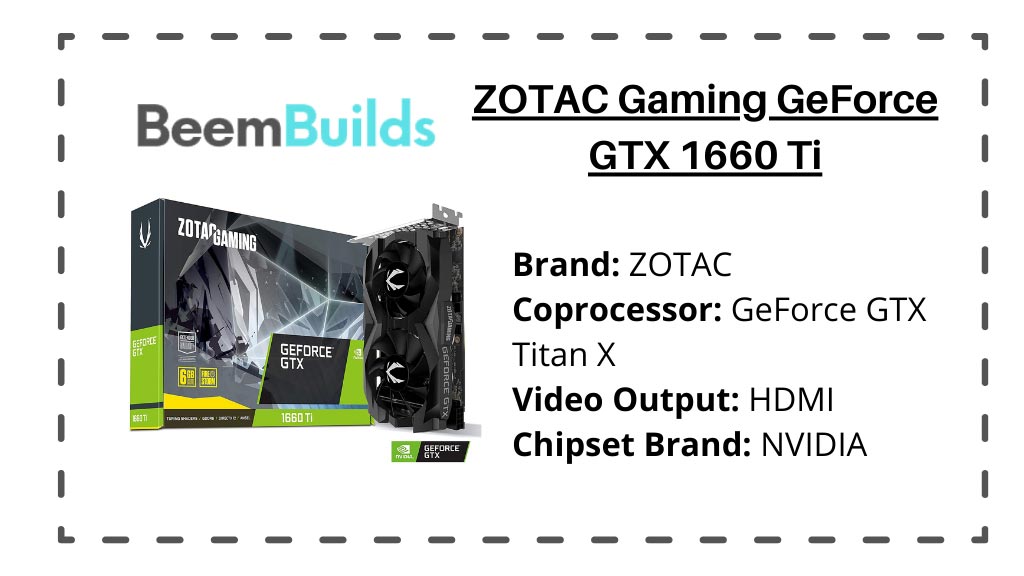 Providing high-quality products to its customers has made Zotac a reliable manufacturer of Nvidia graphics cards. In terms of entry-level graphics cards, the ZOTAC Gaming GeForce GTX 1660 Ti stands out. Compared to other vendors, Zotac is offering a lower price but higher clock rates on this card. Nvidia GTX 1660Ti is an advanced version of Nvidia’s GTX 1060. It handles modern games well at resolutions up to 1440p and 1080p. The aesthetics of this graphics card are excellent since it sports Zotac’s original black and gray color scheme, and it is also extremely compact and performs at its best.
Providing high-quality products to its customers has made Zotac a reliable manufacturer of Nvidia graphics cards. In terms of entry-level graphics cards, the ZOTAC Gaming GeForce GTX 1660 Ti stands out. Compared to other vendors, Zotac is offering a lower price but higher clock rates on this card. Nvidia GTX 1660Ti is an advanced version of Nvidia’s GTX 1060. It handles modern games well at resolutions up to 1440p and 1080p. The aesthetics of this graphics card are excellent since it sports Zotac’s original black and gray color scheme, and it is also extremely compact and performs at its best.
It is significantly more powerful than the Rx 590, despite being more expensive. GDDR6 memory with 192 bit bus speed is faster than GDDR5 and GDDR5x and this graphics card has 6GB of GDDR6 memory. With 1536 Cuda cores, the GTX 1660ti is faster than its predecessor. There is no performance difference between GTX 1060 and GTX 1070, as they only have 1280 CUDA cores. The cooling system in this GPU is outstanding, despite the chip reaching 75C under load due to its compact design. A 500W power supply and an 8-pin power connector are necessary for this graphics card.
You may also love to read: Best Graphics Card for 300 Watt Power Supply
This VR graphics card has great specifications and is reasonably priced, but let’s look at what’s bad about the GTX 1660ti Zotac. RT/Tensors are not present in this GPU, so Ray Tracing is not possible, while for the same amount of money, you can get RTX 2060 or, for a few extra dollars, RTX 2060S which permit Ray Tracing. This GPU cannot perform ray tracing as well as other RTX GPUs, even if GTX series graphics cards support it. GDDR6 memory is supported on this GPU, but it provides only 12GB/s, while most other high-end GPUs offer up to 32GB/s. With all these factors in mind, I recommend GTX 1660ti over RTX 2060.
With the Turing architecture behind it, this graphics card can deliver exceptional performance in modern games. When playing Assassin’s Creed Unity at ultra settings in 1080p resolution and FXAA, this Best GPU for VR is able to achieve 80+ frames per second. The difference in price between this beast and the RTX 2060 is small, but it performs similarly. It can outperform most GPUs in its price range when it comes to VR gaming, but don’t expect anything special.
- Balances performance well overall.
- You can overclock this GPU and it’s efficient.
- Faster than previous generations due to its GDDR6 memory.
- There is a 12GBPS limit on GDDR6 memory.
- Real-time ray tracing and DLSS are not available.
5. Gigabyte GeForce RTX 2070 – Best Enthusiasts Graphics Card for VR
 As a solution to this performance gap between the RTX 2080 and the RTX 2070, Nvidia released the RTX 2070 Super. In comparison with the founder edition of the RTX 2070, this cards is slightly cheaper, but 15% faster. If you are looking for something cheaper, the Gigabyte card is the best choice because it is low priced and offers the same performance as other cards. Gigabyte GeForce RTX 2070 Super reviewers recommend turning off Real-time Ray Tracing for best performance. Although this GPU has a plain aesthetic, it does look good in RGB builds given its Gigabyte original color scheme.
As a solution to this performance gap between the RTX 2080 and the RTX 2070, Nvidia released the RTX 2070 Super. In comparison with the founder edition of the RTX 2070, this cards is slightly cheaper, but 15% faster. If you are looking for something cheaper, the Gigabyte card is the best choice because it is low priced and offers the same performance as other cards. Gigabyte GeForce RTX 2070 Super reviewers recommend turning off Real-time Ray Tracing for best performance. Although this GPU has a plain aesthetic, it does look good in RGB builds given its Gigabyte original color scheme.
As a midrange card, the RTX 2070S cannot compete with other midrange cards in 4K gaming, but it is capable of 1440p. As of now, games require at least this much memory to run on ultra-settings, so 8GB of DDR6 memory is sufficient. It also has 144 texture mapping units in addition to its 2304 shading units. In the Gigabyte RTX 2070S, the high performance chipset clocks at 1750MHz at boost, but because the card has Windforce tri fans and a large heatsink, it can be overclocked a bit.
You may also love to read: Best Graphics Cards for Ryzen 5 1600
There is a lot of great stuff in this Best Graphics Card for VR, but it has some terrible things as well, so be sure to examine them before making your decision. Because AMD competitors offer exactly the same card, Rx 5700xt is a bit cheaper than Gigabyte’s RTX 2070S. It’s fine even without RGB lights if you have an RGB build, which is popular these days. Compared to the founder’s edition of the RTX 2070S, this version is more expensive. However, its cost is still significantly lower than some models of the RTX 2070.
It might be impossible to find a graphics card that outperforms it for its price. The price is currently less than that of RTX 2070, even though it has every feature available in RTX 2080S. A test run with Assassin’s Creed Unity ultra settings and 1080p resolution shows that the GPU outperforms the RX 5700xt. Despite the high price, this graphics card is a great buy if you have the budget.
- Performance in 1440p and 4K is excellent.
- Ray Tracing and DLS are supported in real-time.
- Heatsinks with a large surface area for dissipating heat.
- The price should be cut.
- Have plain aesthetics and lack RGB lights.
- The RX 5700xt offers the same performance for a lower price.
6. Asus ROG STRIX GeForce RTX 2080 TI – Best Overkill Graphics Card for VR
It is every gamer’s dream to have a futureproof build as they do not want to spend money on new hardware every year. In addition to being a futureproof PC for several years, the ROG STRIX GeForce RTX 2080 TI gives you the best performance and VR gaming functionality of any GPU ever released by Nvidia. High overclocking power and quality components are reasons to consider ASUS Strix. Its performance is 40% better than that of the RTX 2080S, despite its price being over a thousand dollars. Despite the graphics card’s many great features, it is among the best for VR gaming.
With its 11GB of memory, this graphics card is capable of handling any VR-based application or game. Although the ASUS Rog Strix 2080ti’s base clock is 1590Mhz, it is easily overclocked to 1750Mhz. In addition to the 4352 Cuda cores, this GPU also boasts 76T RTX OpenGL Open Compute Units. This GPU can play games such as RDR2 or SOTR at 60 frames per second at 4k resolution, which is impressive. Getting this graphics card will require a minimum power supply of 600W, and make sure to get one with two eight-pin power connectors.
Cyberpunk 2077 can be played on this gaming beast; some games do not support RTX 2080ti. This graphics card lacks RGB lighting, unlike most other graphics cards. The RGB lights are available on some other GPUs as well, but I am not recommending spending additional money on them. A price reduction on this GPU would be very welcome since this one is quite cheaper than the Founder Edition. Windows 7 is no longer supported by Microsoft, and many hardware manufacturers are doing the same, and this GPU will not work with Windows 7.
You may also love to read: Best Mining Graphics Card
These Best Graphics Cards for VR are going to make some upcoming games like Cyberpunk a reality. With 1440p resolution and ultra settings, the RTX 2080ti gives Assassin’s Creed Unity 100+ frames per second. It’s easy to get 65+ frames per second with this graphics card on 4K resolutions. Using this benchmark, you can see how well this GPU performs in modern games.
- Supports 120Hz gaming in 4K.
- Graphics card that is energy efficient.
- In-game Ray Tracing and DLSS support.
- Quiet BIOS that runs GPUs at minimum noise.
- RGB lights aren’t present on this GPU
- The plug-in is not compatible with older versions of Windows.
Conclusion
Every gaming build must include a processor and Best Graphics Cards for VR. High-end hardware is needed to enjoy VR movies and games, which are becoming increasingly popular. It’s best to use an Rx 590 for VR, but it’s too old for contemporary games, so Nvidia’s GTX 1660ti is the best alternative. The RTX 2060/Super or AMD RX 5700 are excellent choices if you want to spend more money on graphics cards. Choose the RTX 2070 Super or RTX 2080ti based on your budget if you’re building a high-end enthusiast system.
You may also love to read: Best GeForce RTX 3090 Graphics Cards
Frequently Asked Questions
How should I choose a Best graphics card for VR?
When answering this question, you need to take your budget and needs into account. For users who need a graphics card at an entry-level price for VR, the Rx 590 is a good option, while the GTX 1660ti is a little more expensive. Entry-level graphics cards in the RTX series support VR gaming and are called RTX 2060, however you have to compromise on some aspects. RTX 2070S and RTX 2080ti are recommended for enthusiast builds but not entry-level builds due to their high price.
Can VR be improved by a better graphics card?
As VR gaming requires high-end hardware for you to feel more realistic, a good graphics card won’t be of much help. Among the main problems with the older device is that it doesn’t support high refresh rates, which is an essential aspect of VR games. If your hardware does not support low latency, then input lag can adversely impact your VR gaming experience.
What is VR ready graphics cards?
Only a few graphics card models support VR gaming among the thousands that are available on the market. Because of this, VR games need high-end hardware, and the minimum GPU you should have is a GTX 970 or AMD R9 390. Games and experiences may be negatively impacted if you use all the hardware before these models. Due to this, we put together a list of all graphics cards that support VR and offer great value for money.




